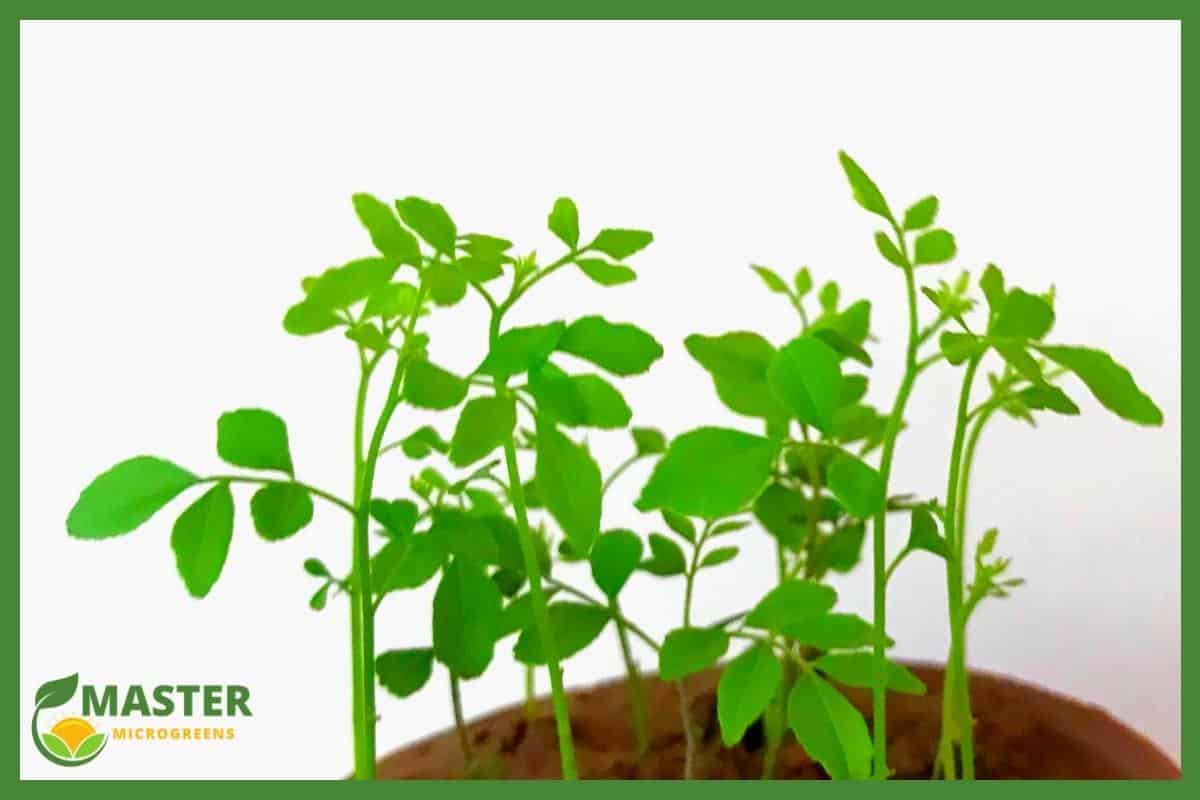Have you ever wanted to grow your own food, but don’t have the time or space for a traditional garden? Well then maybe it’s time to try growing microgreens in coco coir! Microgreens are nutrient-packed plants that can be grown indoors and harvested within days. With just a few supplies and some knowledge of how to care for them, any beginner gardener can start enjoying homegrown fruits and vegetables in no time.
Microgreens may be small, but they pack an abundance of flavor and nutrition into each tiny plant. In fact, studies show that these miniature veggies contain up to 40 times more vitamins than their mature counterparts! Growing your own microgreens at home also has other great benefits; like being able to control what goes into your soil mix – which is where coco coir comes in. Coco coir is an all natural byproduct of coconut husks, making it both sustainable and economical compared to many other potting materials available.
So if you’re looking for a way to get started with gardening without committing too much time or money, why not give microgreens in coco coir a try? You’ll soon find yourself picking fresh greens from your very own indoor garden while reaping the rewards of delicious produce year-round!
What You'll Learn
Advantages Of Growing Microgreens In Coco Coir
Now that we understand what microgreens are, let’s explore the advantages of growing them in coco coir. Coco coir is a great soil alternative for those looking to cultivate their own microgreens at home. It offers many benefits over traditional soils and other substrates:
Yields:
- Coco coir can help increase your yield when compared to using traditional soil as it retains more water and provides better drainage than usual potting composts or soils. This also helps reduce disease issues since there will be less standing water on the substrate surface.
- In addition, coco coir has an air-filled porosity which allows oxygen to reach plant roots more easily, promoting healthy root growth.
Nutrient Value:
- Another advantage of growing microgreens in coco coir is that it contains some essential nutrients such as potassium and magnesium, allowing you to provide nutrition directly to your plants without having to add additional fertilizers or supplements.
- Additionally, coco coir tends to hold onto nutrients longer than most other substrates due its unique texture and structure, ensuring that your plants get the best out of every nutrient application you make.
Soil Alternatives:
- For those who don’t have access to dirt or prefer not to use it for various reasons, coco coir is a great choice for growing microgreens as it is a clean, sterile material with no risk of contamination from pests or diseases like one might find in natural soil sources.
- Furthermore, coco coir is easy-to-use; all you need is warm water and you’re good to go! With just a few simple steps, you’ll have yourself a ready-made bed of nutritious microgreen goodness in no time.
Coco Coir proves itself time and again as an excellent medium for cultivating delicious microgreens – now let’s look into the materials needed so we can start our own crop!
Materials Needed To Grow Microgreens In Coco Coir
To grow microgreens in coco coir, there are a few essential materials that need to be gathered. First and foremost is the coco coir itself, which can usually be found in garden centers or online retailers. Additionally, it’s important to have a growing tray with drainage holes, seed trays, soil mix, and a water sprayer. All of these items will allow for successful germination and growth of microgreens.
The following table provides an overview of each item needed when growing microgreens in coco coir:
| Item | Description | Source |
|---|---|---|
| Coco Coir | Lightweight potting material made from coconut husks | Garden Centers & Online Retailers |
| Growing Tray With Drainage Holes | Container used to hold soil as well as drain excess water away from plant roots | Hardware Stores & Gardening Supplies Stores |
| Seed Trays | Small plastic containers used for starting seeds indoors before transplanting them outside into the ground or larger container pots | Home Improvement Stores & Garden Supply Stores |
| Soil Mix | Combination of organic matter such as peat moss or compost along with perlite/vermiculite for aeration purposes; should also contain some fertilizer | Nurseries & Garden Centers || Water Sprayer Bottle used to evenly distribute water over plants; helps prevent drowning small seeds while also providing optimal moisture Hardware Stores & Gardening Supplies Store |
Having all of these supplies on hand ensures that you will have everything necessary to start your own indoor microgreen garden using coco coir. Once these materials are acquired, you’ll be ready to move onto the next step: planting!
Steps For Growing Microgreens In Coco Coir
Preparing to grow microgreens in coco coir is like priming a canvas for an artist’s masterpiece. After gathering the necessary materials, it’s time to get started! Just as with any project worth doing, some effort and preparation are required before beginning.
The first step to growing healthy microgreens in coco coir is to moisten the medium so that moisture can be evenly distributed throughout the soil mix. To do this, use enough water so that when squeezed between your fingers, there is no dryness left behind. This process should take about 10 minutes and will ensure that your plants have enough water during their early stages of growth.
Next up is planting the seeds. When using coco coir as a substrate for microgreens, simply sprinkle the desired amount of seeds onto the surface and lightly press them into place. Doing so will help promote germination, which typically takes just one or two days depending on conditions such as light, temperature and humidity levels. Once you notice sprouts emerging from the soil media, it means they’re ready for harvesting!
Harvesting and eating microgreens from coco coir requires being mindful of how much of each plant you pick at once – too many leaves plucked all at once may reduce yields over time due to weakened root systems. Additionally, make sure not to leave immature seedlings on top of the soil-mix since these could potentially stunt future growth by competing with other plants for nutrients and resources within their environment. With a bit of patience and practice, you’ll soon become an expert at successfully growing flavorful batches of delicious microgreens right in your own backyard!
Harvesting And Eating Microgreens From Coco Coir
Harvesting microgreens from coco coir is a simple and satisfying task. After the seedlings have reached an ideal size, usually around two inches tall, it’s time to harvest them. Gently grasp each stem between your fingers or use scissors to cut just above the soil line. Don’t pull out the entire plant as this can disturb other plants in the container. Eating microgreens is easy too! They can be eaten raw on salads, sandwiches, or wraps for added texture and flavor.
Cooking with microgreens also adds unique dimension to dishes like stir-fries or omelets. When serving cooked microgreens, add them during the last few minutes of cooking so they retain their vivid colors and delicate flavors. To store harvested microgreens, wash gently in cold water and pat dry before placing them into plastic bags lined with paper towels.
This will keep them fresh for up to one week when stored in the refrigerator. With these tips you’ll soon be enjoying homegrown micro greens straight from your coco coir setup! Transitioning now to common problems and solutions for growing microgreens in coco coir…
Common Problems And Solutions For Growing Microgreens In Coco Coir
Gardening is an unpredictable endeavor, and growing microgreens in coco coir can be no different. It’s like a game of chance – sometimes you win, sometimes you lose. As with any venture, there will be bumps along the road that need to be addressed before they become major issues. Fortunately, many of these problems are preventable if caught early enough!
The most common issue when it comes to cultivating microgreens in coco coir is damping-off, which is caused by fungi or other disease organisms attacking seedlings at the soil surface. This can cause wilting and eventual death of young plants. To avoid this problem, make sure your pots have adequate drainage so water isn’t pooling on top of the soil and keep the potting mix slightly damp rather than overly wet. Another thing to watch out for is overwatering, as too much moisture can lead to nutrient deficiencies in plants or even fungal diseases such as root rot. Make sure you monitor your watering schedule closely and adjust accordingly depending on plant needs.
Finally, pests such as aphids or fungus gnats may also present themselves while growing microgreens in coco coir. The best way to address this problem is through preventive measures such as keeping surfaces clean of debris where bugs could breed or using insecticidal soap sprays to ward off potential invaders before they take hold. If pest control becomes necessary, use organic options whenever possible as they are safer for people and the environment alike!
In summary: Growing microgreens in coco coir can pose some challenges but understanding how to tackle any obstacles that arise can help ensure a successful harvest time after time! Prevention is key when dealing with issues related to soil health, overwatering, nutrient deficiencies, fungal diseases, and pest control – all steps taken today will save time (and stress!) tomorrow!
Conclusion
The process of growing microgreens in coco coir can be a truly rewarding experience! Not only do you get to enjoy the pleasure of watching your greens grow from seed, but harvesting them and eating them is an absolute delight. The taste of freshly grown microgreens is unlike any other – it’s like eating little bursts of flavor that explode in your mouth! It’s so much more delicious than anything you could ever buy at a store. I cannot recommend enough how wonderful it feels to have fresh greens on hand whenever I need them. Growing microgreens in coco coir has been one of the best decisions I’ve ever made – there’s nothing quite like it!





